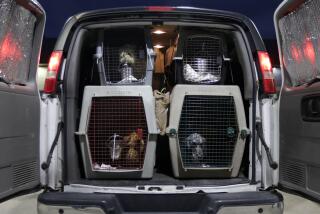Group Claims It Took Test Dogs From Lab at UCI
Thirteen beagles used for medical research at UC Irvine have been stolen, apparently by an animal rights group that said it broke into the campus kennel and freed the dogs to spare them the “pain and misery” of more research.
The dogs, housed in an outdoor kennel at the university’s North Campus, are believed to have been taken Friday night but were not discovered missing until Saturday afternoon after a group calling itself the Animal Liberation Front delivered a typewritten note and photograph to The Times’ Orange County offices.
“This liberation was to protest UCI’s growing use of animals in fraudulent medical research, research nothing will come of except pain and misery to humans and non-humans alike,” the note said.
Masked Man Holds Dog
The color photograph showed a beagle being held by a person wearing a blue ski mask. Protruding from the dog’s forehead was a diode, a plastic tube commonly used to attach electrodes in brain research.
Although the note said 10 dogs had been taken, campus police said 13 beagles were missing.
“Apparently someone cut through two locks, drove a van or something around the back of the kennel, loaded them up and took them away,” said Michael Michell, chief of UCI’s campus police.
Unlike similar cases at other universities where animal rights activists have stolen animals and trashed the adjoining research centers, Michell said there appeared to be no damage to research offices.
“This is different from what they (Animal Liberation Front) usually do,” Michell said. “They usually tear the place up pretty good.”
Kathy Jones, a UCI spokeswoman, said it was the first time that the university had suffered such a break-in. In April, 1986, she recalled that 10 animal rights activists were arrested at the North Campus during a protest against the use of animals in medical research.
“But besides that, this is the first time we have had this kind of quasi-terrorist type of incident,” she said.
Dr. Robert Phalen, who heads the UCI research team that has been using the dogs, said 12 of the beagles had been utilized to study the effects of air pollution on the lungs and on exercise. The 13th dog, the one shown in the photograph, had been used in research studying complications in tracheotomies.
Phalen said the dogs ranged in age from 2 to almost 13 years, and some had been in the program for as long as 12 years.
“These are happy animals,” Phalen said. “I saw that animal with the diode just the other day and it was up and happy and wagging its tail. These dogs probably feel like a child who has been kidnaped, or like someone taken hostage. This lab is their home. They are probably understandably distressed.”
Phalen said the research would be set back because of the loss of the animals.
“It’s hard to say how much this will affect everything,” he said. The tracheotomy study, he added, would suffer the gravest setbacks because of the theft.
Phalen, head of the school’s Air Pollution Health Effects Laboratory, said animal rights activists were misled if they believed the dogs suffered during the research. To the contrary, he said the beagles had been so pampered at the school kennel “that these dogs normally live two or three years longer than a pet will.”
“When our animal care person came in and found out about this, she was crying,” Phalen added. “She’s concerned about the quality of the care they’ll receive.”
University officials said the research program involving the beagles had started in 1975. In all, there are more than 25,000 animals--ranging from hamsters to monkeys and cats--involved in research programs at UCI.
The stolen dogs were just part of those used in the air pollution tests but still could seriously set the program back, officials said.
“The problem is that these dogs have been specially trained,” Phalen said, noting that they run on treadmills on cue to determine the effects of pollution on the lungs.
“They breathe pollutants at levels similar to what we have in L.A.,” he said. “These are non-destructive studies. We work in levels that the animals can’t even sense is destructive.”
When the beagles cease to become efficient in the experiments, Phalen said they are given away as pets.
“I took one home and she lived six more years in our backyard before dying of cancer. And that was after being in the program for eight or nine years,” he said.
Phalen said beagles were used because they were easily trained, generally enjoy exercising and because their lungs are close to the size of a human’s.
More to Read
Sign up for Essential California
The most important California stories and recommendations in your inbox every morning.
You may occasionally receive promotional content from the Los Angeles Times.









